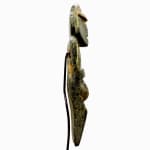Mezcala Andesite Idol, 300 BCE - 300 CE
Andesite
32.5 x 9.8 x 4.5 cm
12 3/4 x 3 7/8 x 1 3/4 in
12 3/4 x 3 7/8 x 1 3/4 in
CC.37
Further images
-
(View a larger image of thumbnail 1
)

-
(View a larger image of thumbnail 2
)

-
(View a larger image of thumbnail 3
)

-
(View a larger image of thumbnail 4
)

-
(View a larger image of thumbnail 5
)

-
(View a larger image of thumbnail 6
)

-
(View a larger image of thumbnail 7
)

-
(View a larger image of thumbnail 8
)

-
(View a larger image of thumbnail 9
)

-
(View a larger image of thumbnail 10
)

-
(View a larger image of thumbnail 11
)

From the mountainous region of Guerrero in modern Mexico, the Mezcala people are noted for their production of stone figures. Little is known about the Mezcala people. They are believed...
From the mountainous region of Guerrero in modern Mexico, the Mezcala people are noted for their production of stone figures. Little is known about the Mezcala people. They are believed to have originated in the Middle and Late Preclassical Periods of the Mesoamerican chronology (700 BC – 200 BC), and survived into the Classical Period, co-existing with the metropolis of Teotihuacan. The later Aztecs excavated Mezcala stone idols and dedicated them in their own temples, and this is how a number of these figures have come down to us. The Mezcala territory has since been denuded of artefacts, by locals hoping to sell them on the art market.
This figure stands with open legs, hands clasped before it above a bulbous stomach, and knees bent. The arms and legs are slender and angular. The face has a protruding jawline and brow ridge, with a triangular protrusion for the nose, and two long trapezoid ears. The face is disproportionately large compared to the rest of the body. The hole between the arms and the chest identifies this as an M-14 type figure, one of the rarer Mezcala figurine types. These openings are cut from the front and back, and are bevelled on both sides. The figure is carved from green-grey andesite, an attractive stone with a mottled appearance and veins.
Some suggest that this figure may have been used as a pestle for the grinding of corn or wheat. In this understanding, the nutrition of society was associated with the phallic form of these figures. Given the lack of wear on this piece, this interpretation seems unlikely. Another, perhaps likelier, interpretation, rests on the distended abdomen of the figure. Given this feature, it is possible that this was a fertility or maternity figurine. Either way, the figure represents a triumph of Mezcala artistic production, skilfully carved into the hard, unyielding stone with a sensitivity to form and an energetic, modernistic style abstraction.
This figure stands with open legs, hands clasped before it above a bulbous stomach, and knees bent. The arms and legs are slender and angular. The face has a protruding jawline and brow ridge, with a triangular protrusion for the nose, and two long trapezoid ears. The face is disproportionately large compared to the rest of the body. The hole between the arms and the chest identifies this as an M-14 type figure, one of the rarer Mezcala figurine types. These openings are cut from the front and back, and are bevelled on both sides. The figure is carved from green-grey andesite, an attractive stone with a mottled appearance and veins.
Some suggest that this figure may have been used as a pestle for the grinding of corn or wheat. In this understanding, the nutrition of society was associated with the phallic form of these figures. Given the lack of wear on this piece, this interpretation seems unlikely. Another, perhaps likelier, interpretation, rests on the distended abdomen of the figure. Given this feature, it is possible that this was a fertility or maternity figurine. Either way, the figure represents a triumph of Mezcala artistic production, skilfully carved into the hard, unyielding stone with a sensitivity to form and an energetic, modernistic style abstraction.










